

Small-Scale Concentrated Solar Power Could Benefit Remote Areas. Clean Power Published on June 26th, 2018 | by Steve Hanley June 26th, 2018 by Steve Hanley Concentrated solar power, or CSP, is usually thought of as a way to create and store large amounts of solar energy to make electricity.
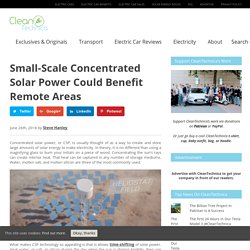
In theory, it is no different than using a magnifying glass to burn your initials on a piece of wood. Concentrating the sun’s rays can create intense heat. A tale of 2 states: Massachusetts and California provide different lessons on growing community solar. איגוד חברות אנרגיה ירוקה לישראל. מרכז יזמות וחדשנות לאנרגיות ירוקות - רותם תעשיות רותם תעשיות, הזרוע העסקית של הקריה למחקר גרעיני נגב, מפעילה מרכז יזמות וחדשנות לטכנולוגיות ירוקות בפארק התעשיות רותם שבנגב, כמנוף לקידום והאצה של התפתחות כלכלית וטכנולוגית של ענפי האנרגיה, המים ואיכות הסביבה בישראל בכלל, ובנגב בפרט.
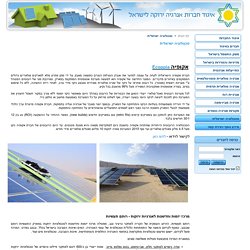
המרכז פועל לקידום, יישום ותיעוש טכנולוגיות מתקדמות בתחומי האנרגיה החלופית והמתחדשת, איכות הסביבה, טכנולוגיות מים ועוד. לאחר המיזוג: סולארפיינט מתחילה להיסחר היום בבורסה בת"א. חברת אור סיטי החזקות מדווחת על השלמת תהליך המיזוג והעסקה עם סולארפיינט, והחברה הממוזגת תתחיל להיסחר היום (א') בבורסה, וצפויה להחליף את שמה לאפולו פאוור.

לפני כשבועיים השלימה סולארפיינט סבב גיוס בהיקף של כ-9.4 מיליון שקל, בשתי הנפקות - הנפקת זכויות והנפקה לציבור. סולארפיינט, שהוקמה ומנוהלת על ידי עודד רוזנברג (המשמש כמנכ"ל) וערן מימון (המשמש כסמנכ"ל טכנולוגיות), מפתחת מוצרים ופתרונות טכנולוגיים בתחום האנרגיה הסולארית לשימוש בכבישים ותשתיות, מאגרים מים ובניינים. המוצר העיקרי אותו מפתחת החברה הינו יריעות סולאריות גמישות, המיועדות להפוך כל משטח תחת פני השמש ליצרן חשמל. Southern school makes its own electricity - Israel Business, Ynetnews. An elementary school in the Gaza border region has completed a solar power system that will completely meet the school's needs.
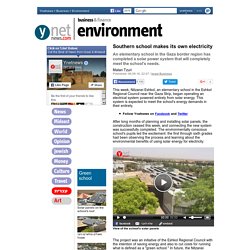
This week, Nitzanei Eshkol, an elementary school in the Eshkol Regional Council near the Gaza Strip, began operating an electrical system powered entirely from solar energy. This system is expected to meet the school's energy demands in their entirety. Follow Ynetnews on Facebook and Twitter After long months of planning and installing solar panels, the construction ceased this week, and connecting the new system was successfully completed. The environmentally conscious school's pupils led the excitement: the first through sixth grades had been observing the process and learning about the environmental benefits of using solar energy for electricity.
The project was an initiative of the Eshkol Regional Council with the intention of saving energy and also to cut costs for running what is defined as a "green school. " New Data Can Help Utilities and Developers Better Market Their Community Solar Programs. Community solar holds a lot of promise.
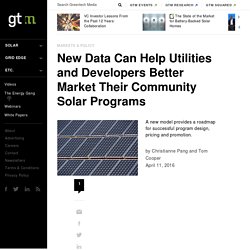
But many programs are mired in challenges. One issue: many utilities and developers have had trouble fully engaging customers. Community solar programs are different from familiar usage-based energy pricing models and are not easily understood by the general public. Hence, providers are faced with the unexpected need to spend more time and money on marketing.
There seems no clear single path to success. As a result, GTM Research's yearly projections for U.S. community solar development through 2020 are roughly 20 percent lower than they were in 2015. To ensure community solar companies save money by marketing their programs right the first time, Pacific Consulting Group (PCG) created a model that takes the guesswork out of program rollouts. The study was based on a survey of 884 respondents from eight states. Love solar power but got no rooftop? "Shared solar" is coming for you. To date, solar power has mostly been available to utilities (as big power plants) or individual home and business owners (as rooftop panels).
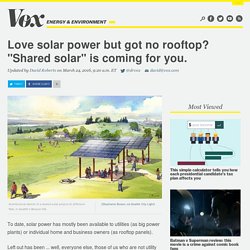
Left out has been ... well, everyone else, those of us who are not utility executives and do not have the money, wherewithal, or suitable rooftops to install solar ourselves. That's a lot of people who love solar power but have no way to get directly involved in it. Happily, that situation is rapidly changing, thanks to the growth of shared solar. Shared solar refers to small-scale solar installations that multiple individuals co-own, or that divide their power output among multiple "subscribed" individuals. It's a way for all those non-rooftop folks to directly support clean energy, while also supporting local jobs and economic development.
Homepage - Ormash Solar Energy. Once cutting edge, solar power becoming as commonplace as commuting. Five solar projects sprouting along the Massachusetts Turnpike and Route 3 are not the largest in the state, but they are among the most visible and striking examples of a solar industry that has grown more rapidly than most policy makers and energy specialists ever imagined.
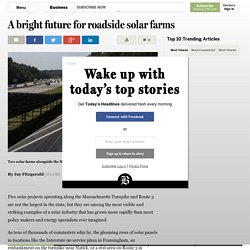
As tens of thousands of commuters whiz by, the gleaming rows of solar panels in locations like the Interstate 90 service plaza in Framingham, an embankment on the turnpike near Natick, or a rest area on Route 3 in Plymouth show how solar power has been integrated into daily life. The Framingham and Natick projects are already generating power; when the other sites in Framingham and Plymouth become operational later this month, the five solar farms will produce a combined 2,500 kilowatts of electricity, enough to power about 500 homes. Advertisement Joanne Rathe/Globe Staff Officials from Ameresco Inc. inspected the site. National Community Solar Partnership. Mission The Partnership’s mission is to leverage the momentum in the public and private sector to expand solar access to new markets (demographic and geographic) and convene relevant stakeholders to assess market barriers and catalyze deployment in low and moderate income (LMI) communities.
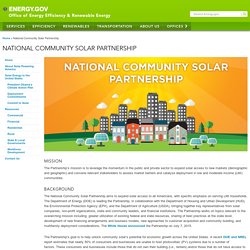
Background The National Community Solar Partnership aims to expand solar access to all Americans, with specific emphasis on serving LMI households. The Department of Energy (DOE) is leading the Partnership, in collaboration with the Department of Housing and Urban Development (HUD), the Environmental Protection Agency (EPA), and the Department of Agriculture (USDA), bringing together key representatives from solar companies, non-profit organizations, state and community leaders, and financial institutions. Why Minnesota’s Community Solar Program is the Best Design - Renewable Energy World. I’ve been asked a lot of questions about Minnesota’s community solar program over the past couple years and it’s time to make one thing clear: Minnesota’s program is the best in the country.
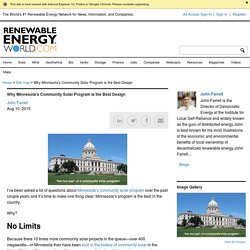
Why? Because there 10 times more community solar projects in the queue—over 400 megawatts—in Minnesota than have been built in the history of community solar in the United States (40 megawatts), with no caps on participation. Minnesota’s program (see infographic) is a comprehensive approach that makes developing community solar projects economically viable and—to emphasize—it does not cap the development of community solar projects. The latter is the key. California Bridges the Green Divide with Nation’s Biggest Solar Program for Low-income Renters - Renewable Energy World.
Solar is not just for homeowners.
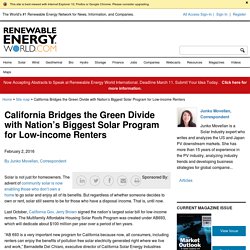
The advent of community solar is now enabling those who don’t own a home to go solar and enjoy all of its benefits. But regardless of whether someone decides to own or rent, solar still seems to be for those who have a disposal income. That is, until now. Last October, California Gov. Cities, States, Industry Increase Commitments to Promote Community Solar - Renewable Energy World. The White House on Nov. 17 said that 40 organizations have joined the National Community Solar Partnership (NCSP) since the initiative was launched in July, bringing the total number of city, state, business and organizational commitments to 68. NCSP is a collaboration between the U.S. Department of Energy (DOE), the U.S. Department of Housing and Urban Development, the U.S. Department of Agriculture, the U.S. 54570.